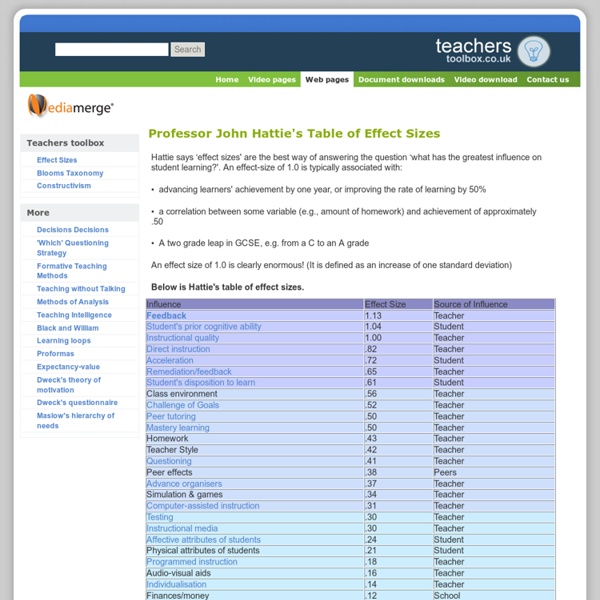Teachers toolbox - Professor John Hattie's Table of Effect Sizes

Visible Learning Archives
Welcome to the second day of the Visible Learning World Conference in London. We’ll keep you updated with live impressions from the conference. For real-time updates make sure to follow the #VLWorld2016 hashtag on Twitter. Conference organizers Osiris Educational Panel discussion with Andy… The Visible Learning World Conference 2016 took place in (surprisingly sunny) London. Recently, John Hattie’s two books Visible Learning and Visible Learning for Teachers have been translated into Chinese. “Improving Schools through Visible Learning: Research, Practice and Impact”. Tagged with: Andy Hargreaves, Barry Hymer, Craig Parkinson, David Hopkins, Deb Masters, Guy Claxton, Helen Butler, James Nottingham, John Hattie, Mick Waters, Shirley Clarke, Tony MacKay, Visible Learning, Visible Learning into Action, Visible Learning World Conference Posted in Visible Learning John Hattie’s new policy paper is a double issue about distractions and solutions.
Bloom’s Digital Taxonomy Resources
As part of preparing for a series of presentations at various conferences this year, I have developed six quick sheets for Bloom’s Digital Taxonomy. These resources outline the different taxonomic levels and provide the Digital Taxonomy Verbs with some (this is not exhaustive) possibilities for classroom use. For the complete Bloom’s Digital Taxonomy go to the Educational Origami Wiki @ Here are the quick sheets: As always I would appreciate comments, feedback and suggestions.
6 cappelli De Bono (Vizzari su Mindomo)
6 cappelli De Bono Cappello rosso Qual è la mia/nostra reazione immediata all'argomento o alla sfida? Che sensazioni ho/abbiamo? Che cosa mi/ci piace o non mi/ci piace? Sono/siamo entusiasta/entusiasti della proposta/dell'idea/del lavoro? Ho/abbiamo qualche brutta sensazione o qualche brutto presentimento a riguardo? Cappello verde Quali alternative si possono concepire? Che cosa farei/faremmo se non avessi limiti fisici o sociali? Che cosa farei/faremmo se avessi/avessimo molte risorse a disposizione? Che cosa farei/faremmo se avessi/avessimo molto tempo a disposizione? Come potrei sorprendere persone competenti in materia? Come potrebbero persone estranee considerare la cosa? Come risolverei/risolveremmo i problemi se avessi/avessimo poteri particolari? Cappello giallo Che cosa posso/possiamo ottenere? Che benefici posso/possiamo aspettarci di bello? Che cosa posso/possiamo cambiare per migliorare ancora? Che cosa mi/ci entusiasma di questa idea o di questo lavoro? Cappello bianco Cappello blu
Intelligenze multiple (Vizzari su Mindomo)
Riflessione metacognitiva
Related:
Related:




Research into what makes the biggest difference to student achievement. Feedback is at the top of the list. This is bidirectional, from student to teacher and from teacher to student. by irsanderson Jun 19